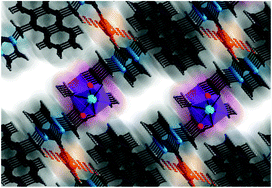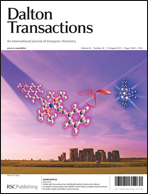The new copper dimer [LCu(DMF)]2(NO3)4(H2O)(DMF)2 (4), where L = [{1,1′-(CH2)2-C14H8)-3,3′-(CH2CO2)2}{(HCN)2CH}], and porous coordination polymers [{L2Cu(OH2)2}2Br2]x (5) and [{L2Zn(OH2)2}2Br2]x (6) have been isolated from reactions of luminescent imidazolium carboxylate ligand, LH2Br2 (3) and the corresponding metal precursors. The reaction between Cu(NO3)2·3H2O and LH2Br2 (3) in DMF at 100 °C yielded bluish green crystals of tetracationic discrete copper dimer 4, the structure of which contains a rare tetracationic [(DMF)Cu(II)]2 dimer unit that is bridged by four carboxylates of two L in a “paddle-wheel” structure. When the reaction was carried out in the presence of a water–ethanol–methanol mixture, light green crystals of 5 were obtained. Molecule 5 comprises two-dimensional (2D) porous coordination polymeric sheets consisting of unique symmetrical dinuclear [(C(O)O)Cu(OH2)2(O(O)C)2]2 building blocks, which are connected by imidazolium anthracene spacers. The infinite 2D porous coordination polymeric sheets are further linked by significant intermolecular hydrogen-bonding interactions by bromide anions to form a three-dimensional supramolecular framework. Interestingly, the reaction between zinc dust and LH2Br2 (3) in H2O at room temperature gave similar structural features to those in 5, though they differ in terms of C–O bond distances and M–O–C angles. The solution-state UV-visible absorption spectra of 2–6 in water exhibits the comparable absorption pattern with decrease in the intensity of absorption from 5, 4, 3, 6 and 2, while the solid-state UV-visible absorption spectra of 2–6 are significantly different from the solution-state UV-visible absorption spectra. The considerable change in the fluorescent emission was observed upon complexation of 3 with corresponding metal precursors and the fluorescent emission was shifted towards the red region in the order of 2, 3, 6, 4 and 5 in water.


 Please wait while we load your content...
Please wait while we load your content...